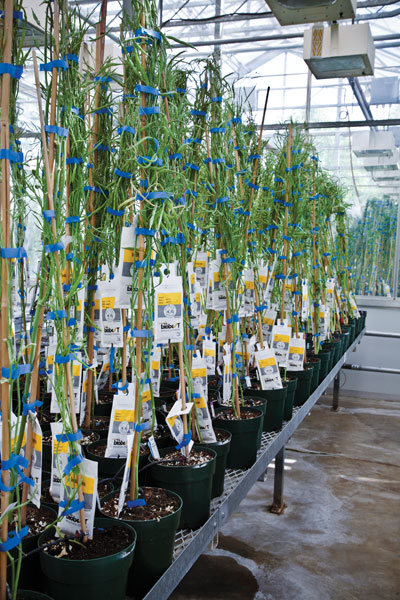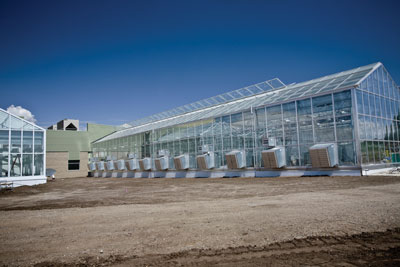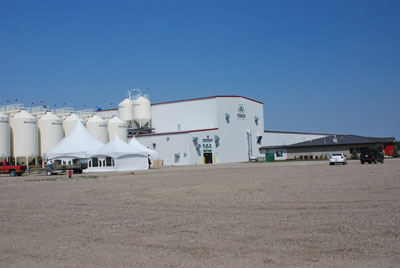
News
Canola companies ramp up their commitment to R&D
Canola has come a long way from the early 1970s when pioneer plant breeders Dr. Baldur Stefansson of the University of Manitoba, and the “Father of Canola,” Dr. Keith Downey at Agriculture and Agri-Food Canada in Saskatoon developed a low erucic acid rapeseed now commonly called canola.
February 24, 2010 By Bruce Barker
Canola has come a long way from the early 1970s when pioneer plant breeders Dr. Baldur Stefansson of the University of Manitoba, and the “Father of Canola,” Dr. Keith Downey at Agriculture and Agri-Food Canada in Saskatoon developed a low erucic acid rapeseed now commonly called canola. Today, canola generates almost $14 billion in economic activity, and while AAFC and the universities continue to innovate with research across the Prairies, a new wave of investment by publicly traded companies swept the country in 2008-09.

|
|
| Western Canada is becoming the global centre for canola plant breeding. (Photo courtesy of Bayer CropScience.)
|
The first wave started in July 2008, when DuPont opened its new Pioneer Hi-Bred canola production facility in Lethbridge, Alberta. The $12-million plant includes office, warehouse and bulk storage space to handle Pioneer brand seed production, cleaning, conditioning, packaging and distribution. The plant covers 30,000 square feet and employs more than 20 people.
Pioneer Hi-Bred also recently opened a new research centre in Carman, Manitoba. Researchers at this station focus on the development of canola, corn and soybean products for Western Canada. Areas of research emphasis include the development of products with increased yield potential, pathology, sclerotinia and blackleg for canola, anti-shattering, improved cold tolerance and herbicide efficacy.
Cargill focuses on specialty oils
Cargill also got into the expansion game when it opened its new specialty canola research and production facility at Aberdeen, Saskatchewan. The research and production centre opened in late 2008, and allows Cargill to centralize its hybrid breeding program in the heart of the commercial production region.
The Cargill Specialty Canola Oils Research and Production Centre will be part of Cargill’s research farm, located about 48 kilometres from Cargill’s canola crush facility in Clavet, Saskatchewan. The research farm supports Cargill’s specialized hybrid breeding and production trials located across Western Canada, with a focus on developing high-yielding agronomic traits and the next generation of output traits.
Cargill also announced the launch of Clear Valley low-saturate canola oil, a high stability canola oil with 4.0 to 4.5 percent saturated fat, 25 percent less saturated fat than conventional canola oil and the lowest amount of saturated fat of any vegetable oil offered to food manufacturers to date. It will be available for customer testing in early 2010. Clear Valley low-saturate canola oil is produced from Cargill’s Victory hybrid seeds specifically designed by Cargill scientists for maximum yield and performance to add value to
farm businesses.
Bayer’s Saskatoon facility creates global research facility
At 4560 square metres of laboratory space with air-purity-controlled greenhouses and phytotron room, the Bayer CropScience canola research facility a few kilometres northeast of Saskatoon, Saskatchewan, will be the global research centre for Bayer’s canola program. The $15-million centre officially opened on July 22, 2009, and will continue to focus on yield and agronomic enhancements, but also on creating new types of healthy canola with different oil profiles.
The centre is adjacent to 560 acres of farmland that will be used for up to 16,000 plots. The facilities will allow up to four generations of canola plants to be grown in a single year, bringing new varieties to market quicker. “When we say it’s our new centre of innovation, our choice of words is very deliberate,” says Garth Hodges, global general manager of Canola for Bayer CropScience, who is based in Calgary, Alberta. “This isn’t just a typical breeding centre or research farm. This is global in its reach and has the express purpose of supporting the most modern molecular breeding techniques available in the world.”
The facility will employ about 40 people, from plant breeders to molecular scientists and plant pathologists.
Monsanto’s University of Manitoba centre breaks ground
Not to be left out, Monsanto Canada broke ground at the University of Manitoba research park for its new $12- million research facility on July 27, 2009. The Monsanto Canada Breeding Centre, which will cover approximately 29,000 square feet and contain office space, labs and greenhouses, will serve as the home to the majority of the breeding effort for Monsanto’s rapidly growing canola business. Approximately 40 staff involved in line development breeding, breeding support functions and the canola breeding management team, will work at the new site, which will also include laboratory facilities for all canola quality analytics, double haploid breeding (tissue culture) and plant pathology.

|
|
| Bayer CropScience’s greenhouses are part of the company’s $15-million global canola research centre. (Photo courtesy of Bayer CropScience.)
|
Plant cultivation facilities such as growth rooms, soil preparation areas and warehouse space are also incorporated into the facility design and will accommodate activities related to canola plant breeding such as crosses, plant cultivation, drying and threshing.
At the ground breaking ceremony, Monsanto also announced an additional $3-million expansion of their Crop Technology Research Centre near Saskatoon, a project that began in the spring of 2008 when Monsanto purchased 159 acres of previously leased land. Since then, the project was designed and a 3600-square-foot research farm office with associated infrastructure was built. Many of the canola hybrids developed by the breeding group will be tested and advanced at this facility. As well, all canola trait development and field testing will be managed there.
Glyphosate pricing volatile
In late September, Monsanto Company in the United States announced it will be cutting the price of Roundup by 50 percent. While the Canadian and US markets are distinctly separated and operate independently, Monsanto Canada’s public affairs director Trish Jordan, says that the price cut in the US will likely have an effect on the Canadian marketplace. “Our goal is to provide growers with a high quality-product at competitive value, and do so in a way that allows us to adjust quickly to any market conditions that arise,” she explains. “We are not making a price move here, but instead are offering our retail network programs that are likely to achieve the same result. The end result for Canadian farmers is that they should see Roundup brand agricultural herbicides offered in the marketplace by retailers at prices significantly lower than today.”

|
|
| Monsanto’s University of Manitoba facility hosts the company’s main canola breeding efforts. (Photo courtesy of Monsanto Canada.) |
Jordan says that Monsanto is in a better position to respond to price volatility, with the separation of the crop protection division from the seeds and traits divison.
There are two primary sources of glyphosate: Monsanto and a group of roughly 50 China-based companies, many of which are government-owned or controlled operations that frequently shift production based on changes in policy and need for the key raw materials. In the past two years, Monsanto has invested $200 million in additional production capacity in a plant in Luling, Louisiana, that supplies formulated Roundup agricultural herbicide brands.
Trait sharing becoming common
Bayer and Monsanto also recently signed an agreement to allow sharing of traits. The deal allows Bayer to work with Genuity Roundup Ready technology, and Monsanto to work with Liberty Link tolerance trait. Bayer also has an agreement with Cargill that gives Bayer access to Cargill’s healthy oil traits, which resulted in the launch of Bayer’s first InVigor healthy oil trait canola in 2008.

|
|
| Pioneer Hi-Bred’s $12-million Lethbridge production facility. (Photo by Bruce Barker.) |
Derrick Rozdeba, manager of integrated communications with Bayer CropScience in Calgary, Alberta, says that the trait sharing gives the companies several options when moving forward with breeding programs. With access to either trait in a breeding program, a company can now breed either trait into a new canola hybrid, or it can stack the trait so that the hybrid is tolerant to both Roundup and Liberty herbicides. “The agreement allows us to go to the other side of the marketplace. We have been successful with the InVigor hybrids, but there is a segment of the market that likes the Roundup Ready trait, and this agreement will open up that market to us,” he explains.
Rozdeba says that the benefit of stacked traits is that a farmer will not be locked into one herbicide choice, and that they could rotate the herbicides in a two-pass application system, in-crop, to target different weeds.
At Monsanto, Jordan says that their plant breeders will initially focus on breeding the LibertyLink trait into Dekalb hybrids, and that stacking the Roundup and Liberty traits are currently a lower priority.
Finally, Bayer CropScience has introduced a trait agreement for their InVigor LibertyLink system where they reduced the cost of Liberty herbicide and moved that cost over on to the
seed cost. “The reduced price of Liberty will give growers more options for making a second pass of Liberty, or to use it at different label rates,” says Rozdeba.
| Two new InVigor canola hybrids introduced Bayer CropScience unveiled two new InVigor canola hybrids for the 2010 growing season. Trials indicate one of them is on track to set yet another yield record for canola, while the other brings the signature InVigor yield performance to another specialty oil hybrid. InVigor 5770: In Western Canada Canola/Rapeseed Recommending Committee (WCC/RRC) public co-op trials in 2007/2008, InVigor 5770 showed yields averaging 135 percent of the checks. InVigor 5770 is a late maturing canola hybrid, best suited for the long- to mid-season growing regions of the Prairies. It is rated resistant to blackleg. InVigor Health 1145: This is the newest hybrid developed through the alliance Bayer CropScience has with Cargill Specialty Canola Oils. InVigor Health 1145 is a high-yielding specialty oil canola with trial yields of 133 percent of check, and will be sold through Cargill and selected independent retails. It is a mid-late maturing canola hybrid, best suited for the long- to mid-season growing regions of the Prairies and is also resistant to blackleg. |